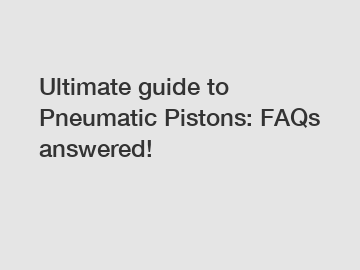Ultimate guide to Pneumatic Pistons: FAQs answered!
**How do pneumatic pistons work?**.
Pneumatic pistons operate through the use of compressed air to generate mechanical motion. When air is compressed and directed into the piston chamber, it pushes against a movable piston head, causing it to move in one direction. This movement can be converted into various types of mechanical work, such as lifting, pushing, or rotating objects.
**What are the different types of pneumatic pistons available?**.

There are several types of pneumatic pistons available, each with its own unique design and advantages. Some common types include single-acting pistons, double-acting pistons, telescoping pistons, and rotary pistons. Single-acting pistons use air pressure to move in one direction, while double-acting pistons can move in both directions. Telescoping pistons are used in applications where a longer stroke length is needed, and rotary pistons are designed for applications that require circular motion.
**What are the key advantages of using pneumatic pistons?**.
Pneumatic pistons offer several key advantages, including high power-to-weight ratio, quick response times, and precise control over motion. They are also cost-effective, easy to install and maintain, and can be used in a wide range of applications. Pneumatic pistons are commonly used in industries such as manufacturing, automotive, and construction for tasks that require reliable and efficient motion control.
**How do I choose the right pneumatic piston for my application?**.
When selecting a pneumatic piston for your application, there are several factors to consider. These include the required force and speed of the piston, the operating environment (such as temperature and humidity), mounting configuration, and available space. It is important to consult with a pneumatic system expert to determine the best piston type and size for your specific needs.
**How do I install and maintain pneumatic pistons?**.
To install a pneumatic piston, first secure it to the mounting surface using appropriate hardware. Connect the air supply lines to the piston according to the manufacturer's instructions, ensuring proper airflow and pressure. Regular maintenance is essential to ensure optimal performance, including checking for leaks, lubricating moving parts, and replacing worn seals or components. Consult the manufacturer's maintenance guidelines for specific instructions on servicing your pneumatic piston.
If you want to learn more, please visit our website how does a water piston pump work, wholesale pneumatic piston pump, gk pump.
173
0
0

Comments
All Comments (0)